In recent years, things didn’t go well enough at Celtic Park. Under the management of Neil Lennon, a 25-point gap opened up between the Hoops and Steven Gerrard’s Rangers, culminating in their bitter rivals earning the 2020/21 title. However, within just months of Rangers’ Premiership win, many things have changed as Ange Postecoglou, a coach with good experience in Asia but who had never worked in Europe, was appointed.
After a very sloppy start at the beginning of the season, Celtic became the best team domestically thanks to a strong run. They took the crown from Rangers while remaining unbeaten in the Scottish Premiership since 19 September 2021, when they lost 0-1 to Livingston. So, how did Postecoglou turn things around? This tactical analysis looks at how Celtic played beautifully with the ball, from a point of view that explains Postecoglou’s interesting requirements and tactics on individual roles.
Functional but flexible full-backs
Postecoglou lined his Celtic up in a back four formation very often, meaning there were always a pair of full-backs on the pitch. Intriguingly, instead of instructing the wide defenders to go high and overlap on the outside, this position is also sometimes required to be in the centre as well.
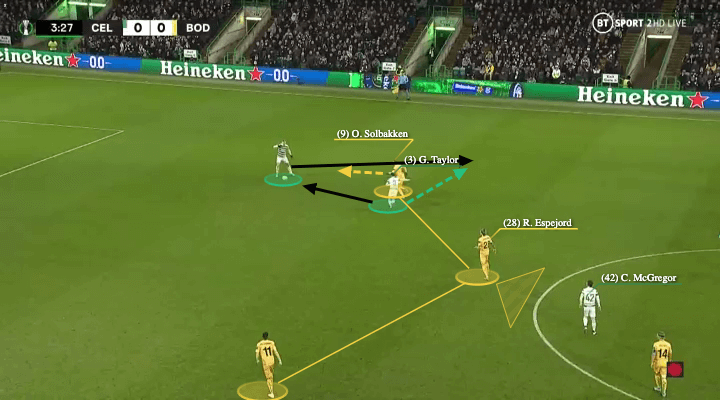
The left-back, Greg Taylor, did not hug the touchline most of the time. Instead, he often played in the midfield to create positional advantages for the team in this area. For example, when they faced Bodø/Glimt’s 4-3-3, the task was to play between the lines and engage their right-winger. We saw Taylor moving inside-out and via Ola Solbakken’s blindside in the first image. Since the wide spaces were vacated initially, it was easy for the centre-back to pass outside and the option was obvious.
Tactically and from a greater picture, you could view the left-back as an additional midfielder to help the 6, as sometimes Callum McGregor was not required to move on a large scale, but to keep the opposition striker in a certain area in the above image. So, when Celtic needed an option behind the first line, the full-back could be the player to receive as Taylor did here.
On those 2v1 occasions, the distances of Celtic players were kept very carefully to make sure they could create conditions to beat the defenders, sometimes by passes and sometimes by runs.
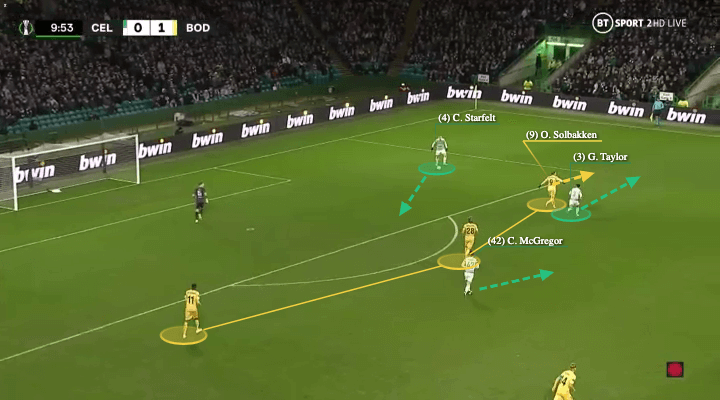
The movements on the blindside by the left-back carried a good dynamic in play because the opposition right-winger would not be able to see the direction, he could only guess. Even if he got it correct, as Solbakken was able to use his movement to cover Taylor in the next scenario, that suggested pressure was brought away from the centre-back for more spaces to carry the ball.
Here, as Taylor moved away from Solbakken, Carl Starfelt recognized the pass to Taylor was not optimal. Instead, as Solbakken moved to the outside, Starfelt carried the ball in the reverse direction to access larger spaces, and with a better angle to play the forward passes.
In the build-up, the same blindside movement was also noted from McGregor, as the Celtic 6 did the same to move the striker away from the centre to offer more spaces for his centre-back as well.
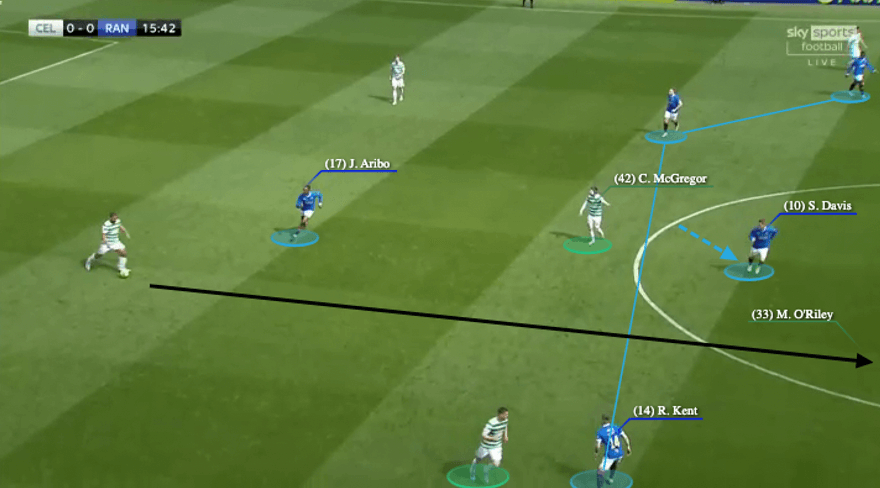
Postecoglou’s Celtic also used a lot of bounce passes, and vertical third-man plays to move the ball forward during the construction phases; the way they did that was very effective with the help of full-backs.
Here, initially, the centre-back broke lines with a forward pass in the half-space — note that the body orientation of the right-back, Anthony Ralston, was not facing Cameron Carter-Vickers. Instead, he had already turned and moved forward to go behind Ryan Kent.
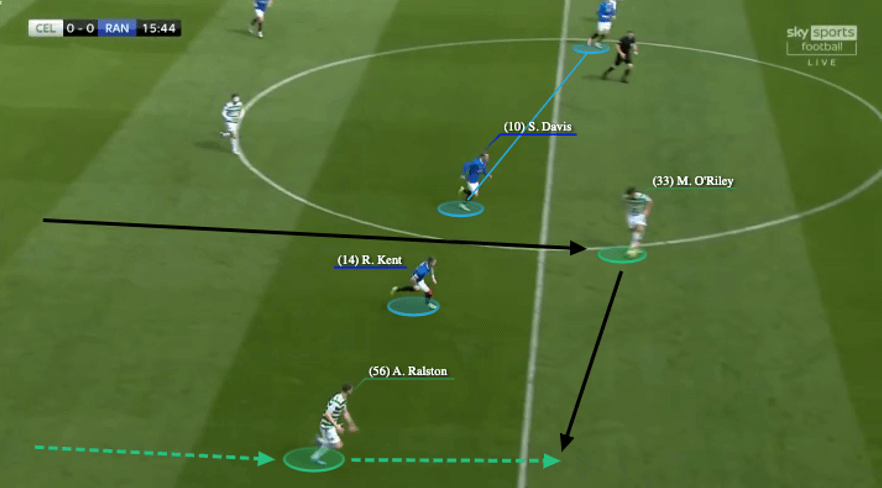
As a result, now, when Matt O’Riley received the vertical pass, he had an easy lay-off option on the flank as Ralston was already there. Then, Celtic could easily go all the way forward as they easily broke the press with the use of full-backs.
The impressive part of this approach and their movements was the players’ understanding of the match picture. Instead of going for the first pass, they were also preparing for the second or even the third pass, because they knew the direction of the attack and so knew how to appear in a correct position to receive the ball.
Of course, the analysis in this section does not suggest that Postecoglou was only using the full-back in one way. He is a flexible coach and when he felt the full-backs could have a bigger impact on the outside or someone else is more suitable in the centre, he would have switched to that conventional method as well.
6 and 8 dictating
In the construction phases of the attack, Postecoglou’s midfielders also had important roles in dictating and managing the flow of the game. All of them must have a good willingness to play, but that was not equivalent to picking up the ball because they have to be in the positions to receive, as we will explain in this section.
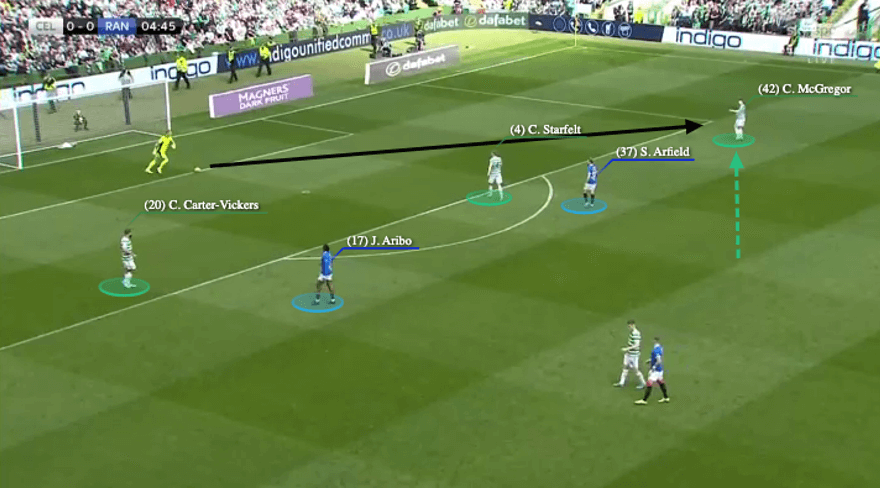
Although Celtic could be playing with a 4-2-3-1 on paper as Wyscout suggested with their stats, with the ball, they were mostly playing with just one holding midfielder only — with McGregor nailed-on for a starting spot in this pivotal role. Postecoglou’s 6 must be very clever in possession phases to support and play between the lines, but also cleverly move into positions to receive the ball.
For example, when Celtic faced a two-man pressing line such as Rangers’ 4-4-2 on the above occasion, they normally did not play with very deep full-backs because this position might have other roles as explained in the above analysis. When the wide defenders were high enough to push the opposition wingers down, the wide spaces outside of the first line were vacated and this was where McGregor should be ready for the ball — a simple 3v2 numerical advantage would help them to move the ball forward.
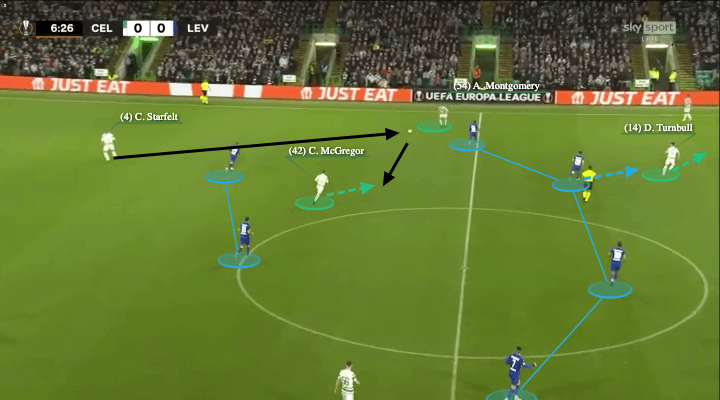
Of course, the 6 must be clever as he must not always play in the first line. On more occasions, he needs to be in spaces between the lines and operate in the midfield with the collaborations with 8, such as the example in the Leverkusen game here.
This time, Celtic chose to go outside-in in the attack to bypass the first line. Firstly, McGregor must be in a position to receive from Adam Montgomery with good body orientation, and also do the basics such as far foot receive, opening the angle to play. However, the scenario didn’t only involve the defenders with the 6, because football is a team game as demonstrated by Celtic, the others also had roles to create the condition to play. We saw David Turnbull staying in space and moving forward to bring away the Leverkusen midfielders so spaces were opened for McGregor between the lines.

Now, we went back to the same example that applied to explain the full-backs’ third-man receiving in the previous section, but now, the focus was shifted to the 6. Willingness to play was one of the criteria mentioned and demanded by the head coach, but the 6 must be smart. Sometimes, he might help the team without moving close to the ball. Instead, if there was a man-marker, McGregor might have pinned his marker in a position to open spaces for teammates.
For example, here, McGregor stayed centrally to attract the Rangers midfielder (Steven Davis) out, he did not have to move to receive when the others were in positions to receive. If he went to the right half-space, then actually he brought Davis and closed that space. So, as the situation in the game showed, he used his position to fix the opponent would be a more optimal way to help the team.
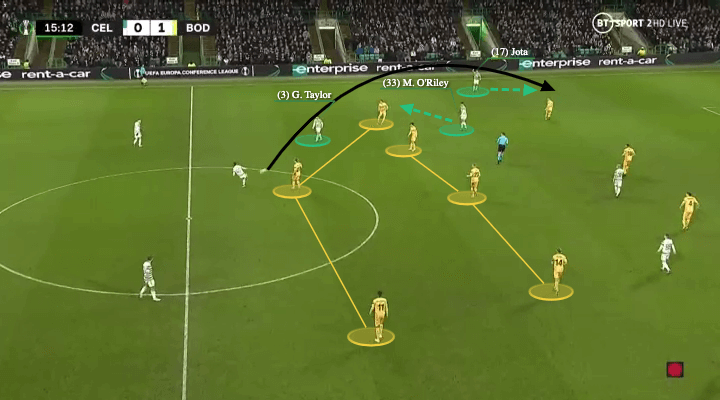
When the midfielders received the ball, the next action they looked for was to break lines, if possible. When there were runners presented, the 6 and 8 should be brave to find them — McGregor demonstrated a good example here against Bodø/Glimt.
Here, Celtic’s attacking move involved rotations you could always see from their games; when the left-back went inside as a 6, the 8 could move outside to use the wide spaces vacated as O’Riley’s move suggested. These rotations might move the defenders or catch their attention, so the passing options were on in the process. In the meantime, the winger was always aggressive to make runs behind such as Jota in this situation, so McGregor could have a longer option to play so the opponents didn’t guess the pass direction easily.
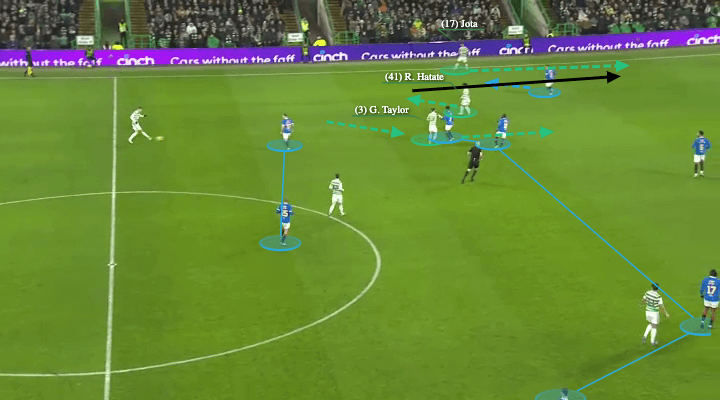
The passes going forward could come from different players and we could spot similar structures. In the Old Firm derby this February, Celtic used so many rotations to create good conditions in possession, as Reo Hatate (8), Taylor (left-back), and Jota (left-winger) were playing on the same flank and making the same moves again.
This time, the passer chose to find Hatate first, but then you see because of the rotations, the other two players (Taylor and Jota) were ready to receive with the movements forward. Due to Taylor’s initial occupation of half-space, he was also able to make some inside runs and that was another way for Celtic to break the last line.
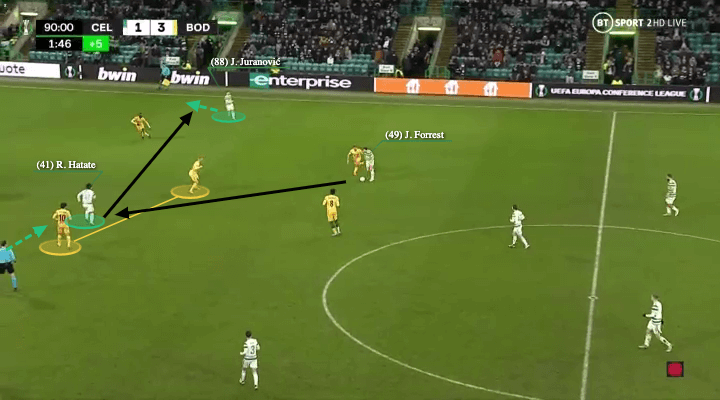
In addition, the 8 should also be able to play in spaces. Sometimes they offered movements to rotate with others, but the likes of O’Riley and Tom Rogic should stay between the lines as well. Or in this example with Hatate, who received in space, he could fix the attention of the wide defender and create 2v1 situations on the outside with his full-back.
The runs and finishing actions
In the last third, Celtic must be very aggressive to make runs and have the desire to score, because having so much possession means nothing if you do not put the ball into the back of the net.
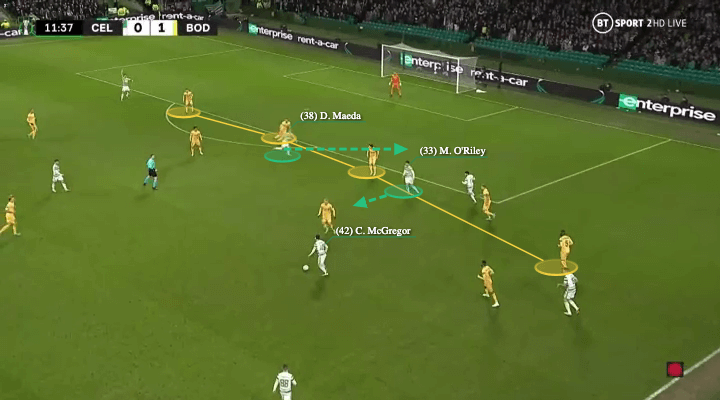
As explained in the previous section, Postecoglou’s 8 always played in spaces to rotate with others. With a view to breaking the last line, the 8 can also attract the defender to open spaces in gaps between defenders.
For example, here, against Bodø/Glimt, O’Riley dropped slightly to receive in space, which would likely engage the opposition left centre-back, so Maeda went behind diagonally to search for depth — a very typical striker movement from Postecoglou’s Celtic.
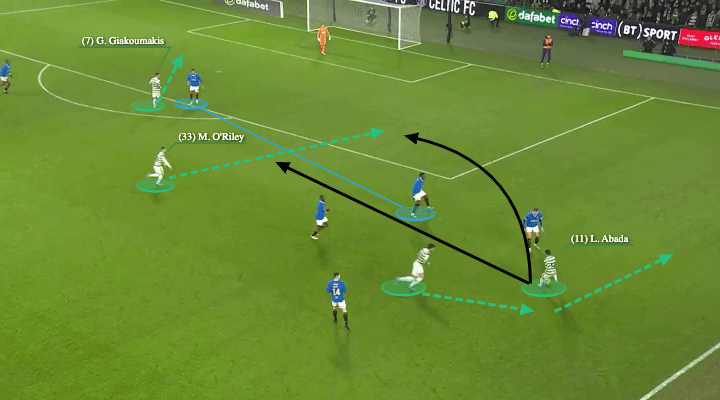
The same could also happen in an alternative manner, such as the striker not searching for attacking depth behind, rather staying in the centre to occupy the centre-back as Giorgos Giakoumakis did here. Since Celtic came from the flank, they dislocated Rangers’ centre-backs and now, O’Riley, the former 8 of Fulham, has a chance to receive in space or go behind with a forward run there.
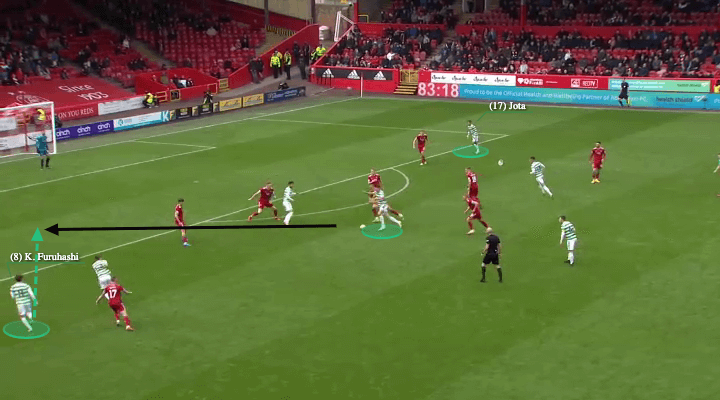
When it came to the finishing movements, Celtic had very good individual behaviours as the players had to be eager to move into goalscoring positions — specifically the winger on the far side. We included their goal against Aberdeen earlier this season to illustrate this point.
When the pass was sliced to the left flank, Jota, the Celtic right-winger and former Valladolid player, was only on the right side, staying outside of the last line and not even inside the penalty box.
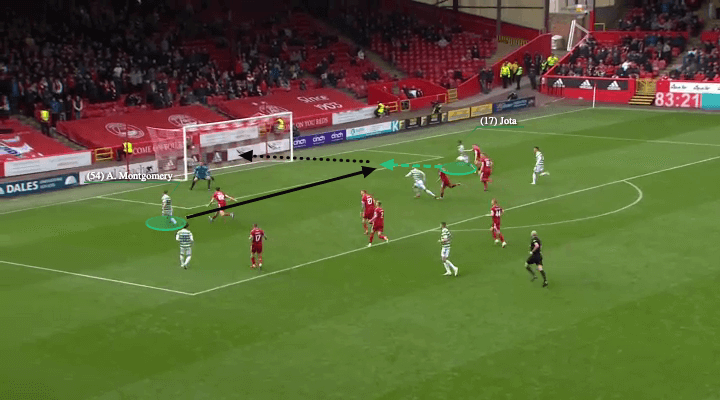
The pass did not find Furuhashi, but Montgomery took it and provided the cross. Now, if you checked Jota’s position again, he was already in the penalty zone to meet the cross. With his sharp acceleration and the initially “irrelevant” position, the opposition left-back was totally caught out and the Portuguese player enjoyed a simple tap-in to finish, after having done the hard part earlier in the move to create such an opportunity. This kind of goal – wingers arriving from the far side — was replicable and gave Celtic the cutting-edge to do real harm to their opponents.
Conclusions
As we have explained in this analysis, in possession, Celtic were one of the best sides in Europe in terms of ideas and style, with a very clear philosophy of how they wanted to play. It’s never easy to play this kind of football with a high level of disciplinary and game understanding, as well as hard work on the training ground. Postecoglou’s contract is ending very soon, and the Bhoys would probably want him to pen a longer deal before bigger clubs from major leagues inevitably send invitations the 56-year-old head coach’s way.





Comments